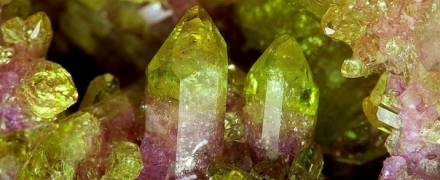open 10 am - 7 pm
laboratory is closed
Vesuvian - green collectible find

Vesuvian is rarely found as a raw material suitable for cutting, more often it is a cabochon-quality material. The color of Vesuvian is greenish-brown, less often yellowish-green and green, sometimes pink, purple, colorless, blue-green. Stones colored green with varying degrees of blue tint contain a structural impurity of chromium and are mined in most cases from the deposits of the Middle Urals. In Russia, finds of gem-quality Vesuvian are known from occurrences in Yakutia, Taimyr, the Middle Urals and Karelia. Jewelry and ornamental garnet-vesuvian jade (a metasomatic rock containing vesuvian in one amount or another, more often up to 25%) was at one time mined at the Munilkan deposit (Yakutia). Also, manifestations of similar material, but not forming large objects, are also known throughout the entire length of the Urals - from the polar to the South. In recent years, jewelry and ornamental material of a garnet-vesuvian rock of purple-pink color, reminiscent of the jade of the Munilkan deposit, but having less blockiness, has been received from Kazakhstan. Often the essentially vesuvian breed is called vesuvianite in commercial practice. But it should be remembered that a breed with such a name does not exist.
В геммологической практике бывают весьма увлекательные случаи с диагностикой ювелирных вставок
Но помимо редкости цвета и высокой стоимости таких камней, многие розовые камни выделяются одной замечательной особенностью – они проявляют плеохроизм, то есть в зависимости от положения осмотра камня он может иметь дополнительные оттенки – оранжевый или пурпурный.
Currently, gemstones are produced by two fundamentally different technological methods - the High Pressure - High Temperature method (“HPHT”, High-pressure & High-temperature) and the Chemical Vapor Deposition (“CVD”, Chemical vapor deposition) method. The "HPHT" method is the most tested classical synthesis method, which can be used both carbon deposition on diamond from flux melts and catalytic reactions. In "CVD" synthesis, diamond growth occurs on a seed during carbon deposition mainly from a gaseous medium at relatively low temperatures and pressures.
Jewelry and precious stones are just such a category of goods, when buying which you need to pay attention to many criteria.
Sogdianite is a rather rare mineral and more often it can be found as a collection material (moreover, in systematic collections), and it is extremely rare in jewelry.






